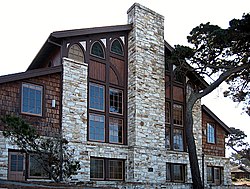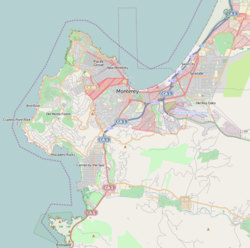Asilomar Conference Grounds
|
Asilomar Conference Grounds
|
|

Merrill Hall, Asilomar
|
|
|
Location in the Monterey Peninsula
|
|
| Location | Asilomar Blvd., Pacific Grove, California |
|---|---|
| Coordinates | 36°37′11″N 121°55′53″W / 36.61972°N 121.93139°WCoordinates: 36°37′11″N 121°55′53″W / 36.61972°N 121.93139°W |
| Area | 9 acres (3.6 ha) |
| Built | 1913 |
| Architect | Julia Morgan |
| Architectural style | Arts and Crafts Movement and American craftsman Bungalows |
| NRHP Reference # | 87000823 |
| Significant dates | |
| Added to NRHP | February 27, 1987 |
| Designated NHL | February 27, 1987 |
Asilomar Conference Grounds is a conference center built for the Young Women's Christian Association (YWCA). It is located east of what was known as Moss Beach on the western tip of the Monterey Peninsula in Pacific Grove, California. Between 1913 and 1929 architect Julia Morgan designed and built 16 of the buildings on the property, of which 11 are still standing. In 1956 it became part of the State Division of Beaches and Parks of California's Department of Natural Resources, and Moss Beach was renamed Asilomar State Beach. Asilomar is a derivation of the Spanish phrase asilo al mar, meaning asylum or refuge by the sea.
The annual conference of the YWCA of the Pacific Coast had been held at the Capitola, California hotel through 1911. Probably because they had outgrown the space, and because the YWCA had a goal of purchasing grounds, Phoebe Apperson Hearst hosted the 1912 conference at her Hacienda in Pleasanton, California, with all proceeds of that year's conference going toward the purchase of a permanent home. A resulting YWCA committee persuaded the Pacific Improvement Company of Pacific Grove, California to deed 30 acres (120,000 m2) to the YWCA in 1912. In early 1913 the YWCA announced that Julia Morgan, already at work on the Oakland YWCA building, would design the campgrounds. Construction began in the spring of 1913 and in August 1913 the Social Hall and the lodging Longhouses opened with nearly 300 girls in attendance. Merrill Hall, the last of Morgan's designs for Asilomar, was dedicated in 1928.
Several other prominent California women including Ellen Browning Scripps, Mrs. Warren Olney, Jr. and Mary Sroufe Merrill were involved in the creation of the retreat.
The winning entry in the naming contest was by Helen Salisbury, a Stanford student. Her entry created a portmanteau from two Spanish words: and .
Asilomar was declared a National Historic Landmark in 1987 for its role in women's recreation, the development of the YWCA, and the resort nature of nearby Monterey, California.
...
Wikipedia


